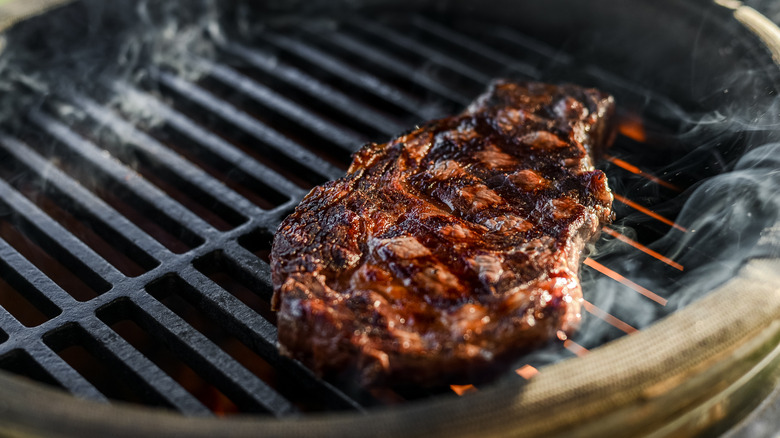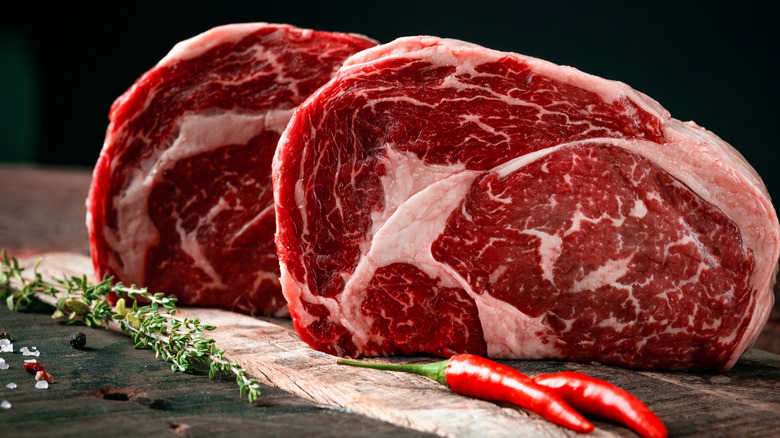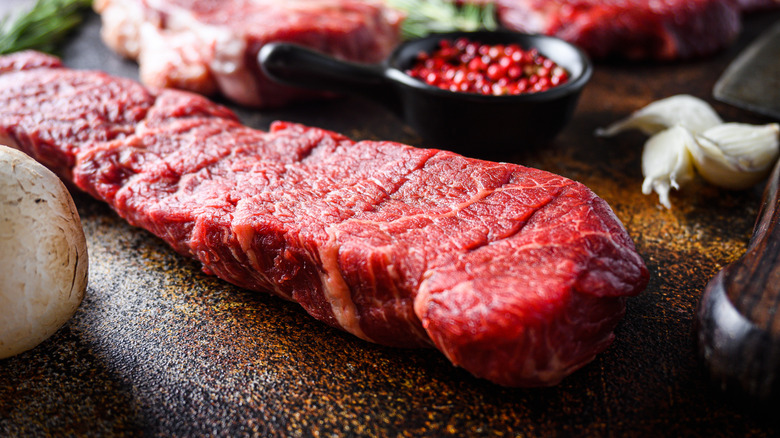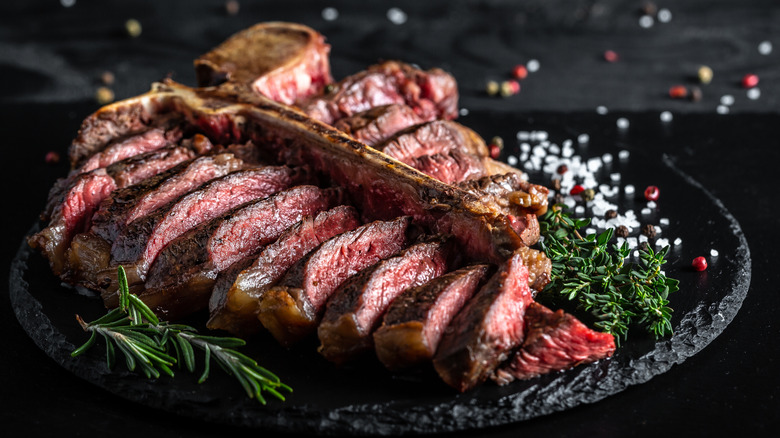Why Different Cuts Of Steak Require Different Grilling Methods
For meat lovers, there's nothing better than a perfectly grilled steak, but if you want to rival the pros, you'll have to do more than just sprinkle on some salt and throw it onto the grates. A few rules of thumb apply to cooking all steaks: Bring the meat to room temperature first, let it rest before slicing, and don't underestimate carry-over cooking time (steak will continue to cook after you remove it from the heat, possibly taking that medium-rare to a solid medium).
A word to the wise during prep, though, from Barbehow – two hours is the limit for leaving meat out of the fridge before cooking, for food safety reasons. But it won't take that long for steaks to reach room temperature; about 20 minutes will do it.
Another piece of wisdom: Since each cut of steak comes from a different part of the cow, they each have unique textures and flavors, and the length and method of cooking will depend on the specific cut. There are three main factors to consider when choosing your cut of meat and corresponding approach to grilling.
More fat means more cooking
Marbling, the term for the white lines you see throughout a cut of meat, is basically a fancy word for fat. When it comes to steak, fat is where the flavor lives: If grilled correctly, that marbling will make the steak juicier as it heats through.
The more marbling a cut of meat has, the longer its cooking time should be, says chef and culinary consultant J. Kenji López-Alt (via Serious Eats). The goal is to allow the fat time to melt, imparting flavor and moisture throughout the steak as it does. Think of the old saying "chew the fat" to describe a long conversation. Solid fat is pretty tough and takes some work to get through; when it softens, though, it creates a bite that's just the opposite: tender and full of melt-in-your-mouth flavor.
Marbling is largely dependent on the feed of the cow and the location of the cut on the cow's body. The degree of marbling inversely correlates to the amount of use the muscle receives, MasterClass explains. Muscles that don't get engaged as frequently, like the loin, have more marbling. Heavily used, leaner muscles, like the leg or rump, are less marbled. Typically, you'll also see much less marbling in grass-fed steak compared to conventional, grain-fed cows. While this may mean less moisture when cooked, grass-fed beef tends to have a more "robust" taste, making it a unique (and healthier, says WebMD) option to add to your next barbecue.
Fattier cuts perfect for grilling include ribeye and flat iron, while cuts like tenderloin and flank tend to be leaner (via Steak School).
Thin or thick? It matters
There is a delicate balance between the thickness of the steak and the length of cooking time. Thin cuts tend to quickly overcook, J. Kenji López-Alt notes in Serious Eats, especially if you're aiming for a golden crust (and why wouldn't you?). Thinner steaks are best placed on the grill over high heat and cooked quickly with the lid open. A good marinade can help tackle toughness in thin steaks — just make sure not to marinate much longer than an hour.
With thicker cuts, as Lopez-Alt further explains, the so-called perfect steak has a crusty exterior and an appropriately cooked mid-section. The danger for some cooks, however, is that they may achieve that perfect crispiness on the outside while the center remains under-cooked.
So, how to tackle a thick steak? It's best to start over low, indirect heat and then sear at the end over direct heat. Keep the lid closed to trap the warmth when cooking over indirect heat and open during searing over direct heat (via CNet). Popular thin cuts for grilling include flank, hanger, and skirt. Filet mignon, ribeye, sirloin, and strip fall on the thicker side (per Fine Cooking), so adjust your technique accordingly.
Sear your bone-in steak
There's an ongoing debate in the culinary community as to whether bone-in steaks simply taste better. According to Steak School, those who favor keeping the bone intact say doing so helps to keep the cut juicy, as the bone marrow is infused into the meat during cooking (though detractors would argue that's unrealistic).
If you're grilling with the bone in, remember that these cuts will require a longer grilling time than boneless cuts. Ensuring even and complete cooking requires a little patience; it's best to sear the steak over direct heat first, then close the lid when the meat is moved to indirect heat, as CNet advises.
A bone-in cut is something to keep in mind the next time you feel like channeling your inner caveman at your grill-out. With the crispy burnt edges of lard surrounding the bone, eating this steak may be the one time you actually want to chew the fat. One of the most popular bone-in steaks fit for the grill is the aptly named T-bone, which is the strip and tenderloin in one, separated by a T-shaped bone.



